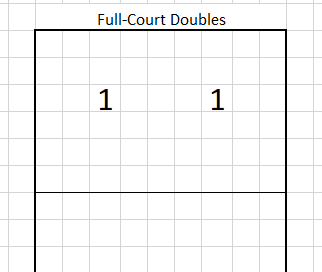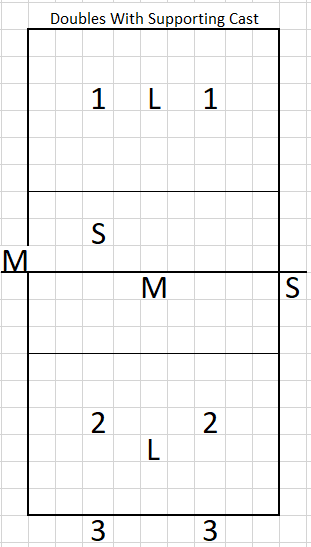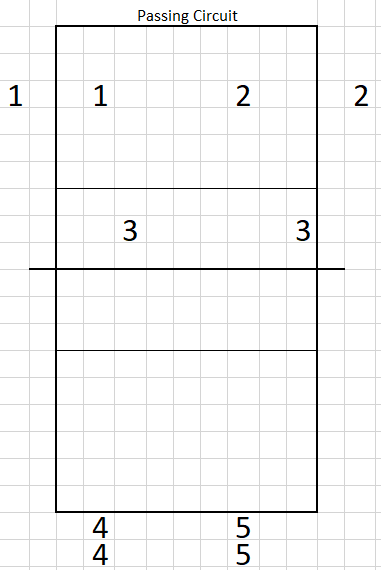November is Juniors Month at Smarter Volley. Juniors clubs have been underway in Europe for a little while now, and in North America most boys have already started and girls are just now getting going. Because of that, most of the content this month will be geared around the Juniors game and be directly applicable for Juniors coaches. But, a lot of it will be useful for coaches at other levels, including this one. Enjoy!
What Are Doubles Drills?
I define Doubles drills as drills where you have a team of two people.1 That doesn’t necessarily mean that all doubles drills are 2 v 2, and, to twist the term even a bit further, due to practice logistics, you sometimes need to have 3 people on a doubles team. Umm… okay, let’s see how that’s going to work out.
Why Doubles?
Doubles drills generally fall under the category of Small-Group Games. Coaches have always used Small-Group Games, in volleyball and other sports, for a variety of reasons: they are fun, players touch the ball frequently, players interact with the ball in slightly different ways, etc. Let’s just assume that Small-Group Games are useful and move on.
They are logistically simple. Teams have either an odd or even number of players. Teams with even numbers of players can divide into doubles with no planning required. Teams with an odd number just need either one coach to hop in, one team of 3, or one player in Supporting Cast. More on that later, but either way, it’s pretty easy.
Doubles variations often enable you to extend one court into multiple court, or multiple stations. At the NCAA level and above, you often have more than 1 court per 10 players. At the Juniors level, your ratio is worse than this. That is: you have lots of players on one court. Some doubles variations allow you two play two games on one court, or easily create off-court stations, to get your players more contacts.
Types Of Doubles Drills
I want to make this less about any one specific drill and more about different classifications of doubles drills to allow you to mix-and-match them as you see fit.
Full-Court Doubles
Pretty self-explanatory. You play 2 v 2, on a full-size court. Most people are familiar with how to play this, although, in my experience, very few people naturally gravitate to play full-court doubles. It’s also slow-moving. If you have 12 players (6 teams of 2), most of them are waiting in line.
Full-court doubles drills that have more utility in a Juniors setting are wave-oriented warmup drills, such as a cooperative Exchange (where the pair comes off the court after hitting the ball over) or a competitive drill where the plays cannot jump and spike, like Tennis.
Full-Court Doubles With Supporting Cast
Doubles becomes a little more useful in a Juniors setting when we make it… a little less doublesy. In this example, “Doubles” basically becomes 4 v 4, because we’re adding some Supporting Cast. These are players that might not be involved in the scoring or the main focus on the drill2 but fill the drill out to make it work better. So in this case, there's a setter and a libero on the receiving side and a middle blocker and a libero on the serving side. Since your team probably has 2 setters and (at least) 2 middles, you also have a setter and a middle waiting to waive on with them.
Then, you have 6 pin hitters who wave through the doubles portion of the game, serving/passing/hitting/defending.
This is just one example of what I mean that “Doubles” doesn’t mean that every game is 2 v 2. It’s more about the organization of it. In this case, you create 6 teams of doubles:
(1) 2 outside/opposites (2) 2 outside/opposites (3) 2 outside/opposites (4) 2 setters (5) 2 middles (6) 2 liberos.
And then you can do all sorts of stuff within that framework. You can do Single-Skill Circuits (see below) for those positions and then transition to a competitive game. You can do a Split-Court (see below) game and then transition to a Full-Court With Supporting Cast game, etc. The organization is just quick and easy this way.
Single-Skill Circuits
4-Ball Passing is an example of a Single-Skill Circuit. In the linked article, I use a straight rotation, but you can also have pairs of players that rotate through. In the setup I show here, the 4s serve to the 1s (who alternate in and out with each other) and the 5s serve to the 2s (who alternate) while the 3s are doing setting: one sets while the other is a target and then they switch. (And, as I note in the article, you can also do this both ways, especially if you have 12 or more players.)
Split-Court Doubles
One of the most useful functions of Doubles in a Juniors environment is when you go Split-Court. Now you have two games going at once because you’re playing on a narrow court. Narrow-Court games lose a bit on the attacking end (because you eliminate angles, etc) but they are great for Serve/Pass training. In this case, 1s plays 3s while 5s refs. 2s play 4s while 6s ref. Play it like a pool play.
Incorporating Into Practice
I like using Doubles to start practice and I like using a Single-Skill → Split-Court → Full-Court With Supporting Cast progression.
So for example, we might start with a Single-Skill circuit like 4-Ball Passing (which you can do both ways, or one-sided, while you do blocking or digging on the other side), which takes somewhere between 10 and 15 minutes to rotate through.
Then, I’ll go from there into a Split-Court drill. I might do another skills-oriented drill like Split-Court PSH (where we’re not playing it out, just repping pass-to-attack), or we might go right into a competitive Split-Court Doubles. If you use the 6 teams pool play, you can play a full pool of 3-minute games in 12-15 minutes.
At this point, we can go into a Full-Court With Supporting Cast, which looks more like 4 v 4 than 2 v 2, but you’re putting the emphasis on certain positions. The nature of Doubles stuff tends to focus on the Outsides, because they Serve, Pass, and Attack out of Serve Receive. Have this portion last another 15 minutes or so.
If you’ve used this progression, you’ve gone from single skills to competing on the full court with a lot of touches, particularly in the serve/pass phase, you’ve taken about 45 minutes, and now you’re ready for the main phase of your practice, which should be 6 v 6-oriented.
Yes, that’s the amazing insight you come here for. I’ll take that $7 now.
But also: they could be, depending on how you coach it.






